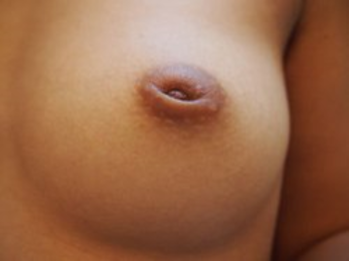For many women, their desire for breast enhancement begins with more beautiful nipples. A simple outpatient surgery can dramatically improve the look of your breasts. Women choose nipple repair at Plastic Surgery for:
Correction of inverted nipples
Nipple reduction
Areola reduction
Treatment of puffy areolas
Inverted Nipple Treatment
An inverted nipple is a condition where the nipple, rather than pointing outward, retracts into the breast. In some cases, the nipple may temporarily protrude when stimulated, but in others, the inversion remains regardless of stimulation. It may affect both men and women.
Around 10-20% of women are born with inverted nipples. Most common variations are caused by short ducts or a wide areola muscle sphincter. It may also occur after sudden and major weight loss.
The most common causes of inverted nipple are:
Congenital
Breastfeeding
Trauma caused by conditions such as fat necrosis, scars or as a result of surgery
Breast Sagging, Drooping or Ptosis
Breast cancer including breast carcinoma, Paget’s disease and Inflammatory Breast Cancer (IBC)
Breast infections or inflammations such as mammary duct ectasia, breast abscess or mastitis
Genetic variant of nipple shape such as Weaver syndrome, Fryns - Aftimos syndrome, Chromosome 2q Deletion or congenital disorder of glycosylation type 1A & 1L or Kennerknecht-Sorgo-Oberhoffer syndrome
Gynecomastia
Holoprosencephaly, recurrent infections, and monocytosis
Pregnancy
Tuberculosis
Nipple inversion is often graded as Grade 1, Grade 2 and Grade 3.
With Grade 1inverted nipples, the nipples can be pulled out easily, using finger pressure around the areola. The nipple maintains its projections and rarely retracts. Also, they may occasionally pop up without manipulation or pressure. Milk ducts are not compromised and breast feeding is possible.
With Grade 2 inverted nipples, though the nipple can be pulled out, it is not as easy. Breast feeding could still be possible.
With Grade 3 inverted nipples, the nipple is severely inverted and retracted and can rarely be pulled out physically requiring surgery in order to protract. Milk ducts are often constricted and breast feeding is impossible. Moreover, the patient may suffer with infections, rashes, or problems with nipple hygiene.
After a careful history and examination, you will be advised which procedure is best for you. The classification of your nipple inversion grade will determine the procedure you require. The mild forms of inverted nipple respond to non-surgical measures such as a course of niplette external suction, where a device is used to create a vacuum effect on the nipple.
In most cases, a minimally invasive technique is used where a small incision is placed at the base of the nipple, which becomes virtually imperceptible as it heals. Through this incision, a very fine instrument is used to release the tethering fibers and foreshortened ducts that hold the nipple in its inverted position. A suture is placed beneath the nipple to maintain its position. The inverted nipple correction surgery is performed safely, comfortably and conveniently in the surgeon’s office under local anesthesia. The surgery may take an hour to complete. The recovery is rapid and you may return to work the following day, with light cardio exercise resumed 3 days after. The first 10 – 14 days you should not wear a bra, camisole tops or other non-compressive garments.
Areola Reduction
Patients who have beautiful breasts with large areolas can reduce the size of the areolas. The procedure is done by removing some skin from around the areola, decreasing the size to that of which the patient desires.
The areola reduction procedure can be done on OPD basis or day care, however the best recommendation is to perform the procedure in the operating room under local anesthesia or local with sedation. The patient goes home the same day, and the stitches are absorbable and hence do not need to be removed.
The postoperative of the areola reduction does not require many restrictions. Three days after the areola reduction, you can return to normal activities. This technique is often performed along with breast reduction surgery. The areola reduction procedure can also be performed as an isolated surgery for patients who just want to reduce the size of the areola and not affect the breast size.

